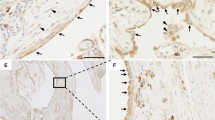Abstract
TNF-α is postulated to play a significant role in regulating TGF-β1 expression. In lung fibroblasts, for example, TNF-α is supposed to induce TGF-β1 via AP-1 activation. TNF-α receptor, knock-out mice are resistant to induced fibrosis and over-expression of TNF-α causes increased TGF-β1 production in mice. Therefore, we investigated whether TNF-α mRNA levels are associated with the TGF-β1 mRNA levels of blood leucocytes in humans. Quantitative real-time PCR of TNF-α and TGF-β1 was performed in 118 Germans. Calculations of expression were made with the 2−ΔΔCT method. When the investigated population was divided in two groups (TNF-α low and TNF-α high) by the median of the determined TNF-α expression, highly significant (p < 0.0001) differences of TGF-β1 mRNA expression were revealed. Additionally, dividing the investigated population into quartiles of the determined TNF-α expression showed significantly different TGF-β1 mRNA expressions. Comparing the determined CT-values of TNF-α in context with these of TGF-β1, a coefficient of determination R 2 = 0.4635 was calculated. In this study we demonstrated in vivo a significant association of the relative TNF-α/B2M mRNA expression and the relative TGF-β1/B2M mRNA expression in 118 Germans.



Similar content being viewed by others
References
Bartram, U., and C.P. Speer. 2004. The role of transforming growth factor beta in lung development and disease. Chest 125: 754–765.
Sime, P.J., and K.M. O'Reilly. 2001. Fibrosis of the lung and other tissues: New concepts in pathogenesis and treatment. Clinical Immunology 99: 308–319.
Selman, M., V.J. Thannickal, A. Pardo, D.A. Zisman, F.J. Martinez, and J.P. Lynch 3rd. 2004. Idiopathic pulmonary fibrosis: Pathogenesis and therapeutic approaches. Drugs 64: 405–430.
Samad, F., K.T. Uysal, S.M. Wiesbrock, M. Pandey, G.S. Hotamisligil, and D.J. Loskutoff. 1999. Tumor necrosis factor alpha is a key component in the obesity-linked elevation of plasminogen activator inhibitor 1. Proceedings of the National Academy of Sciences of the United States of America 96: 6902–6907.
Warshamana, G.S., M. Corti, and A.R. Brody. 2001. TNF-alpha, PDGF, and TGF-beta(1) expression by primary mouse bronchiolar-alveolar epithelial and mesenchymal cells: tnf-alpha induces TGF-beta(1). Experimental and Molecular Pathology 71: 13–33.
Phillips, A.O., N. Topley, R. Steadman, K. Morrisey, and J.D. Williams. 1996. Induction of TGF-beta 1 synthesis in D-glucose primed human proximal tubular cells by IL-1 beta and TNF alpha. Kidney International 50: 1546–1554.
Phan, S.H., M. Gharaee-Kermani, B. McGarry, S.L. Kunkel, and F.W. Wolber. 1992. Regulation of rat pulmonary artery endothelial cell transforming growth factor-beta production by IL-1 beta and tumor necrosis factor-alpha. Journal of Immunology 149: 103–106.
Sullivan, D.E., M. Ferris, D. Pociask, and A.R. Brody. 2008. The latent form of TGFbeta(1) is induced by TNFalpha through an ERK specific pathway and is activated by asbestos-derived reactive oxygen species in vitro and in vivo. Journal of Immunotoxicology 5: 145–149.
Sullivan, D.E., M. Ferris, H. Nguyen, E. Abboud, and A.R. Brody. 2009. TNF-alpha induces TGF-beta1 expression in lung fibroblasts at the transcriptional level via AP-1 activation. Journal of Cellular and Molecular Medicine 13: 1866–1876.
Helmig, S., B. Hadzaad, J. Dohrel, and J. Schneider. 2009. Influence of the Cyp1B1 L432V gene polymorphism and exposure to tobacco smoke on Cyp1B1 mRNA expression in human leukocytes. Drug Metabolism and Disposition 37: 1490–1495.
Vandesompele, J., K. De Preter, F. Pattyn, B. Poppe, N. Van Roy, A. De Paepe, and F. 2002. Speleman: Accurate normalization of real-time quantitative RT-PCR data by geometric averaging of multiple internal control genes. Genome Biology 3:RESEARCH0034.
Pfaffl, M.W. 2001. A new mathematical model for relative quantification in real-time RT-PCR. Nucleic Acids Research 29: e45.
Nakamura, Y., R. Kano, A. Hasegawa, and S. Watanabe. 2002. Interleukin-8 and tumor necrosis factor alpha production in human epidermal keratinocytes induced by Trichophyton mentagrophytes. Clinical and Diagnostic Laboratory Immunology 9: 935–937.
Zhang, X., L. Ding, and A.J. Sandford. 2005. Selection of reference genes for gene expression studies in human neutrophils by real-time PCR. BMC Molecular Biology 6: 4.
Kim, S.J., A. Glick, M.B. Sporn, and A.B. Roberts. 1989. Characterization of the promoter region of the human transforming growth factor-beta 1 gene. The Journal of Biological Chemistry 264: 402–408.
Geiser, A.G., S.J. Kim, A.B. Roberts, and M.B. Sporn. 1991. Characterization of the mouse transforming growth factor-beta 1 promoter and activation by the Ha-ras oncogene. Molecular and Cellular Biology 11: 84–92.
Blobe, G.C., W.P. Schiemann, and H.F. Lodish. 2000. Role of transforming growth factor beta in human disease. The New England Journal of Medicine 342: 1350–1358.
Helmig, S., A. Belwe, and J. Schneider. 2009. Association of transforming growth factor beta1 gene polymorphisms and asbestos-induced fibrosis and tumors. Journal of Investigative Medicine 57: 655–661.
Helmig, S., N. Aliahmadi, and J. Schneider. 2010. TNF-α gene polymorphisms in asbestos induced diseases. Biomarkers. ahead of print
Sime, P.J., R.A. Marr, D. Gauldie, Z. Xing, B.R. Hewlett, F.L. Graham, and J. Gauldie. 1998. Transfer of tumor necrosis factor-alpha to rat lung induces severe pulmonary inflammation and patchy interstitial fibrogenesis with induction of transforming growth factor-beta1 and myofibroblasts. The American Journal of Pathology 153: 825–832.
Liu, J.Y., and A.R. Brody. 2001. Increased TGF-beta1 in the lungs of asbestos-exposed rats and mice: Reduced expression in TNF-alpha receptor knockout mice. Journal of Environmental Pathology, Toxicology and Oncology 20: 97–108.
Liu, J.Y., D.M. Brass, G.W. Hoyle, and A.R. Brody. 1998. TNF-alpha receptor knockout mice are protected from the fibroproliferative effects of inhaled asbestos fibers. The American Journal of Pathology 153: 1839–1847.
Grattendick, K.J., J.M. Nakashima, L. Feng, S.N. Giri, and S.B. Margolin. 2008. Effects of three anti-TNF-alpha drugs: etanercept, infliximab and pirfenidone on release of TNF-alpha in medium and TNF-alpha associated with the cell in vitro. International Immunopharmacology 8: 679–687.
Author information
Authors and Affiliations
Corresponding author
Additional information
Some of the results are included in the thesis of P. Stephan
Dedicated to Prof. Woitowitz on occasion of his 75th birthday
Rights and permissions
About this article
Cite this article
Helmig, S., Stephan, P., Döhrel, J. et al. TNF-α mRNA Expression Correlates with TGF-β mRNA Expression In Vivo . Inflammation 34, 255–259 (2011). https://doi.org/10.1007/s10753-010-9231-2
Published:
Issue Date:
DOI: https://doi.org/10.1007/s10753-010-9231-2




